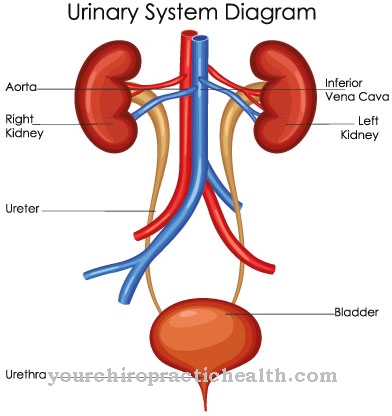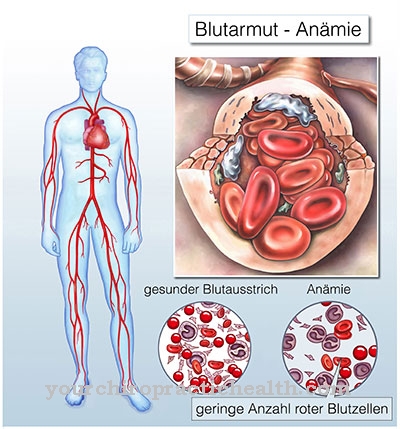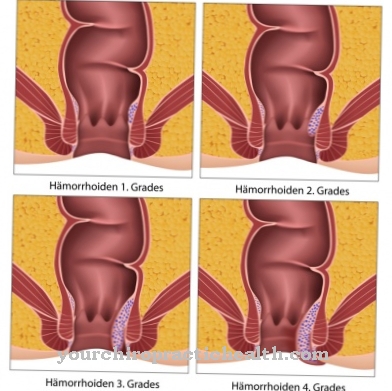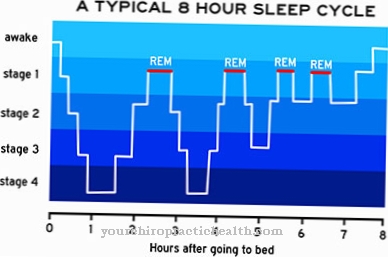Ascites or Ascites is an accumulation of fluid in the abdominal cavity and is usually a symptom of an advanced underlying disease with a mostly poor (unfavorable) prognosis. In the majority of cases, ascites correlates with cirrhosis of the liver.
What are ascites?

© 7activestudio - stock.adobe.com
Ascites (also known as ascites) is a pathological accumulation of fluid in the free peritoneal cavity (abdominal cavity), which usually manifests itself as a symptom of a progressive underlying disease with a mostly poor prognosis.
In most cases, ascites manifests itself in the form of an enlarged abdominal circumference or a bulging abdomen with an elapsed navel area, which is often preceded by flatulence (gas). In some cases, an umbilical hernia can develop as a result of the ascites.
Ascites can be differentiated into serious (clear to yellowish), chylous (milky), hemorrhagic (bloody) and purulent (bacterial) ascites on the basis of its appearance.
causes
The most common cause of ascites is advanced liver failure such as cirrhosis (80 percent). Cirrhosis of the liver can be caused by drug and / or alcohol abuse, chronic hepatitis, autoimmune hepatitis, non-alcoholic steatohepatitis (fatty liver hepatitis) and, in rarer cases, by hemochromatosis (iron storage disease) or Wilson's disease (copper storage disease).
Significantly, as the cirrhosis progresses, the liver becomes increasingly scarred. This impedes blood flow, which leads to blood congestion in the abdomen. The pressure forces the blood out of the vessels and exits into the free abdominal cavity. This process is also catalyzed by the reduced synthesis of blood proteins, in particular of albumin, by the increasingly insufficient liver.
In addition, malignant (malignant) tumors and inflammatory changes in the peritoneal cavity (peritonitis) or pancreas (pancreatitis) can cause ascites. Right heart and kidney failure are also considered to be beneficial factors.
Symptoms, ailments & signs
Ascites can manifest itself through a variety of symptoms, ailments, and signs. First of all there is a swelling of the abdomen, which is usually painless and increases as the disease progresses. There may also be an umbilical hernia, which manifests itself as pain in the area of the navel and the noticeably curved navel.
Many affected people gain weight and in some cases (for example, if there is accompanying peripheral edema) also suffer from water retention in the arms and legs. It can also lead to gastrointestinal complaints. Flatulence and diarrhea, but also nausea and vomiting are typical.
Ascites can be recognized by the fact that the symptoms mentioned persist over a longer period of time and increase in intensity in the course of this. In addition, ascites often occurs in connection with inflammation of the peritoneum, cancer and other diseases. Those affected usually suffer from a general feeling of illness.
In the course of the weight loss, the body may be deficient.Typical deficiency symptoms are dizziness, concentration disorders and a general decrease in physical and mental performance. These symptoms can be used to clearly diagnose ascites.
Diagnosis & course
Ascites can be detected by palpation (palpation) and percussion (tapping) of the abdomen from an accumulated fluid of about 1 liter. In addition, the diagnosis is confirmed by an abdominal sonography, by means of which fluid quantities from 50 to 200 ml can be determined.
If the cause is unknown, an ascites puncture with subsequent analysis of the punctured fluid and / or a computed tomography is usually used. If the punctured fluid is milky or bloody, a laparoscopy should be carried out to determine whether it is caused by trauma or tumors. A purulent ascites, on the other hand, indicates an inflammatory disease of the abdominal cavity (peritonitis). In addition, if liver insufficiency is suspected, the liver values (especially albumin) are checked.
If left untreated, pronounced ascites can lead to an inguinal hernia or umbilical hernia, a disturbed sodium-potassium balance, kidney failure and tachycardia. In general, the prognosis depends on the specific underlying disease. If the ascites occurs in connection with cirrhosis of the liver, this is a prognostically poor sign, as around half of those affected die within 5 years of the diagnosis.
On the other hand, ascites as a result of acute pancreatitis usually regresses once the underlying disease has healed.
Complications
The ascites is associated with various complications. Abdominal wall addiction almost always causes hernias in the intestinal wall. The tears can become inflamed and lead to serious infections in the abdomen and intestines. The increased intra-abdominal pressure also increases the risk of hydrothorax and further damage to the gastrointestinal tract.
Furthermore, ascites can cause sequelae such as dyspnoea, an elevated diaphragm or an upside-down stomach. In addition to often severe pain, fever symptoms and feelings of pressure, a bacterial virus infection can cause further complications such as acute kidney failure. In cirrhosis of the liver, ascites increases the risk of variceal bleeding. A particularly dangerous complication is spontaneous bacterial peritonitis, an emigration of intestinal bacteria to other parts of the body.
The disorder often occurs without significant symptoms such as fever or pain in the abdominal area, but leads to death in up to 50 percent of all patients. When treating ascites, complications can arise if the intestinal wall is injured during an operation. If a local anesthetic is administered, allergic reactions can occur. The diagnostic ascites puncture can cause infections and excessive bleeding. Injury to organs in the abdomen is rare.
When should you go to the doctor?
If ascites is suspected, a doctor should be consulted as soon as possible. If there is an unusual increase in weight or swelling in the abdomen, a doctor must clarify the cause. The same applies if all of a sudden a general malaise, a sensation of pressure in the abdominal region or a sharp pain under the breastbone occurs. If these symptoms persist for more than a few days, it is advisable to seek medical advice. A doctor should also be consulted in the event of persistent flatulence or symptoms of constipation.
Blood in the urine or stool as well as vomiting or diarrhea are other warning signs that require medical evaluation. Patients who have heart disease, tumors of the peritoneum, or acute pancreatitis should speak to a doctor.
It is possible that ascites is also caused by a chlamydial or gonococcal infection, tuberculosis or an inflammatory vascular disease. Patients with a relevant medical history should have any unusual symptoms clarified immediately, as ascites may already have developed. Rapid treatment may then be of vital importance.
Doctors & therapists in your area
Treatment & Therapy
The therapeutic measures for ascites depend on the extent and the underlying disease. In the case of mild ascites, drug therapy with diuretics (including spironolactone, xipamide, furosemide) in combination with minimized fluid intake (1.2 to 1.5 liters per day) aims to reduce or flush out the fluid in the free peritoneal cavity.
The kidney values should be checked regularly, since too fast flushing out can cause renal insufficiency (hepatorenal syndrome). If drug therapy is unsuccessful or if there is pronounced ascites, paracentesis (ascites puncture) may be an option. Since high concentrations of blood proteins are derived with the liquid, liver function should be checked. If the liver is not functioning properly, albumin substitution by infusions is indicated as compensation.
As part of a surgical procedure, a TIPS (transjugular intrahepatic portosystemic stent shunt) to minimize pressure in the portal vein system or a peritoneovenous shunt, through which the fluid can be drained via a catheter, can also be implanted.
Basically, the underlying disease of ascites should always be treated. Liver transplantation may be indicated if there is cirrhosis of the liver. Tumors or their metastases in the abdominal cavity are usually treated chemotherapeutically, while bloody or milky ascites as a result of trauma may have to be treated surgically.
Outlook & forecast
The prognosis for ascites depends on the underlying disease. Since this is not a stand-alone disease but a sequela of previous illnesses, the cause of the underlying disease must first be found and treated. If this succeeds, the ascites will also recede completely until it has completely disappeared.
In the case of serious diseases such as cancer, the prognosis depends on the time of diagnosis and the type of tumor. If it is treatable and discovered early, the chances of recovery are often good. This changes as soon as the tumor has spread or there is already significant damage to the tissue.
If the underlying disease is chronic, the prognosis is also less optimistic. Chronic diseases have a progressive disease course. There is therefore a steady increase in existing complaints. Treatment attempts to influence the course of the disease and delay the progression for as long as possible. In addition, individual symptoms are combated as far as possible. However, there is seldom a cure.
To minimize the symptoms of ascites, the excess fluid is drained off during one treatment. However, since it re-forms due to the disease, this is not an intervention that can bring about a cure.
prevention
An ascites can be prevented through consistent therapy of the potential underlying diseases. In addition, in most cases ascites is accompanied by cirrhosis of the liver, which is particularly caused by alcohol and drug abuse. Vaccinations against inflammatory liver diseases (hepatitis) are also a prophylactic measure against ascites.
Aftercare
Follow-up care after ascites depends largely on the causal disease and the course of the disease. In the case of a positive underlying disease, follow-up care must initially take place every two weeks or monthly. During the follow-up check-ups, the doctor will, among other things, measure the blood values and, if necessary, also perform a physical examination and again take samples from the abdominal cavity.
An anamnesis is also taken. Depending on the underlying disease, the doctor will ask about any accompanying symptoms of ascites and the general condition of the patient and include them in the further planning. If there are no complications during treatment and the ascites resolves as planned, the intervals between follow-ups can be extended.
If the ascites occurs without any further symptoms, it must be checked whether another, as yet undiscovered cancer is the cause. Further examinations are then necessary for clarification. A few patients have recurrent fluid retention during follow-up. Then an indwelling catheter or permanent drainage must be placed. If permanent drainage was placed during therapy, it must be checked and removed if necessary. In addition, any accompanying symptoms must be clarified, which must be cured after the actual therapy.
You can do that yourself
In the case of ascites, medical treatment is based on the extent of the symptoms and the underlying disease. A weak ascites does not necessarily require comprehensive therapy. In most cases, it is sufficient to take gentle diuretics, which, in conjunction with rest and bed rest, promise quick relief. At the same time, the fluid intake must be reduced to ensure that the infected fluid is flushed out.
After the acute phase, the body's water balance must be balanced again by taking in more fluids. In addition, the diet must be changed. A healthy and balanced diet, which is best prepared in collaboration with a nutritionist, should reduce the symptoms quickly. If complications should arise, the responsible doctor must be informed. A relapse may have developed or there is another problem that needs to be clarified and, if necessary, treated.
If a surgical procedure is carried out, the patient must take care of himself. Physical activity should be avoided after the operation. This is especially true if there is a serious underlying disease such as a tumor. In the case of bloody ascites, further medical examinations are necessary after the operation.





.jpg)







.jpg)

.jpg)
.jpg)











.jpg)